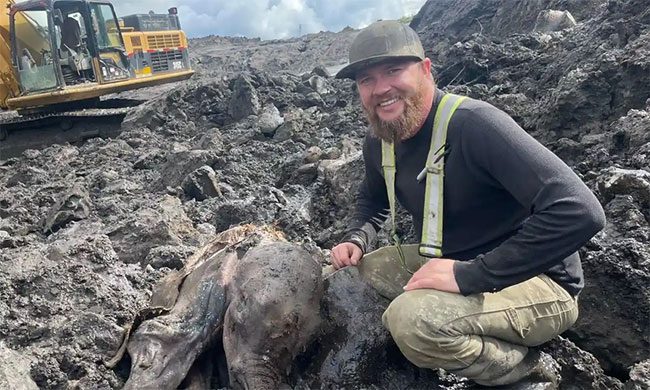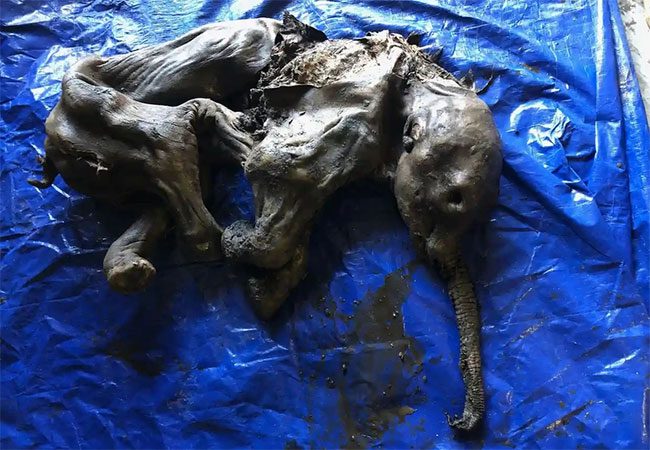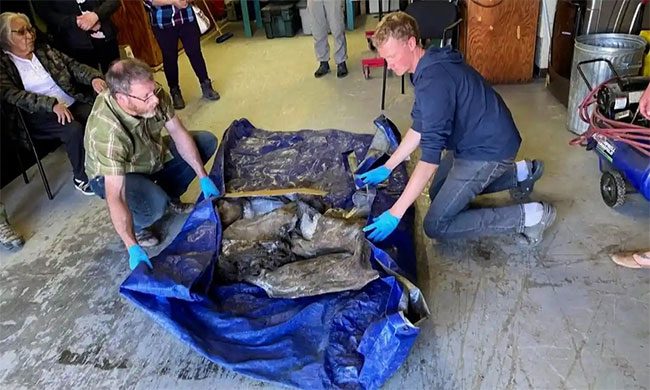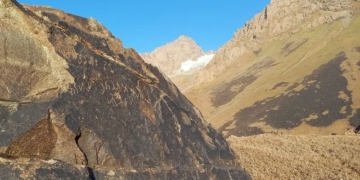A worker accidentally discovered the mummified remains of a baby woolly mammoth while mining for gold in a remote area of Canada.
“I had only been a gold miner for 30 days when this shocking discovery occurred. Treadstone Gold, the company I work for, had just begun its second mining season at Eureka Creek, a remote area in Yukon, northwest Canada,” said Travis Delawski, the first person to discover the mummified remains.
On the afternoon of June 21, Delawski was operating an excavator like any other day. The excavator was equipped with a large metal attachment, allowing him to dig through the permafrost.
The area he was working in was surrounded by pine trees and was about 20 meters deep from the surface. When he approached a frozen bank, the first thing he saw was a skull.
Gold miners often uncover the bones of ancient animals in this area. Like other team members, Delawski was trained to carefully remove these finds, according to the Guardian.

Delawski and the mummified woolly mammoth. (Photo: Treadstone Gold).
Unexpected Archaeological Discovery
“You should come down here. I think I’ve found a mummy,” Delawski called to Brian, his boss, to check the scene.
“Is it a human body?” Brian asked.
“I think it’s a buffalo or some kind of animal,” he replied. At that moment, he thought he was facing a few bones. But upon closer inspection, Delawski realized that this mummy was something much more unusual. It still had skin, ears, and what looked like a trunk.
“It looks like a small elephant. I think it’s a baby woolly mammoth,” he told Brian over the radio.
Brian instructed him to excavate the remains and bring them straight to the staging area. Initially, the gold miner only uncovered the front half of the body, so he carefully used the excavator to check the surrounding area.
Eventually, he discovered the hind legs, rear, and tail of the woolly mammoth. The overall length of the mammoth was about 140 cm.
Delawski loaded the mummy into a barrel and transported it to the main camp of the mine. Brian was astonished to see that the remains were still intact.

The mummified baby mammoth found at Eureka. (Photo: Guardian).
The remains were so well-preserved that they appeared to have died only about a week ago. The pores on the skin and the footprints were still intact.
Brian contacted paleontologist Grant Zazula from the Yukon government. He promised to bring a field survey team immediately. In the meantime, the mummy was covered with wet blankets and tarps.
The geological survey team was thrilled to see the mummy. They spent several hours examining the site and discovered numerous woolly mammoth hairs and traces of ancient vegetation.
After examining the remains, the survey team concluded that this was a female about one month old. It likely died during the Ice Age, at least 30,000 years ago.
A Stormy Journey
The remains were preserved with ice during transport to Dawson City. As the remains left the mining area, an incredible storm appeared out of nowhere.
Thunder and heavy rain poured down continuously. In fact, hailstones the size of golf balls fell from the sky, forcing the gold mining operation to halt.
“It was like a scene from a movie, as if we had discovered something beyond just a woolly mammoth,” Delawski said.
It took a few days for Delawski to realize the significance of this discovery. The curly-haired woolly mammoth he found is considered the most complete and best-preserved specimen ever found in North America.

The remains were wrapped after a ceremony by the Tr’ondek Hwech’in community. (Photo: Guardian).
The area where the mummy was found is within the territory of the Trʼondek Hwechʼin Indigenous people.
The elders of the Tr’ondek Hwech’in named the mammoth Nun cho ga, which means “large baby animal” in the Han language. The community held a blessing ceremony at Eureka, where Nun cho ga was discovered.
“Nun cho ga is beautiful. This is one of the most incredible Ice Age animal mummies ever discovered,” said paleontologist Grant Zazula.
Woolly mammoths once roamed North America from about 300,000 to 10,000 years ago. Some studies suggest they went extinct due to climate change, while many assert their extinction was related to humans.
“I’m still focused on gold mining, although I’m aware of what else I might find. Who knows, maybe the mother of Nun cho ga is still out there,” Delawski said.





















































